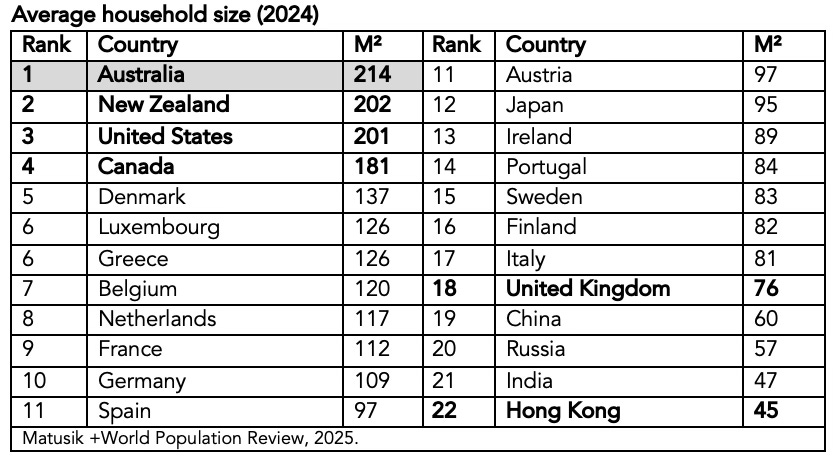How big is your home?
And why that might soon change
Aussies like their space. Always have.
In fact, according to the latest data from World Population Review, Australia ranks number one in the world when it comes to average house size - coming in at a whopping 214 square metres.
That’s bigger than the average home in the United States (201 m²), Canada (181 m²), or even our mates across the Tasman in New Zealand (156 m²).
For context, the global average is around 100 m². Most European countries fall under that. The UK, for example, averages just 76 m² per home. In Hong Kong?
Try 45 m².
So yes, by global standards, we live large.
But here’s the rub: that era might be ending.
Australia’s large homes were built on three things: abundant land, car-centric suburbs, and decades of rising real estate wealth.
For much of the last 40 years, bigger was better. Four bedrooms, two bathrooms, double garage, backyard for the kids and a barbie out the back.
Yet, things are shifting.
For one, land is no longer cheap nor is it plentiful as it once was. The cost of a typical housing lot in our major cities has skyrocketed over the past two decades, and especially since Covid.
At the same time, lot sizes have shrunk. Two decades ago, the average new block in a capital city was around 600 m². Today, it's often closer to 400 m² or less.
And they are set to decline further if you ask me.
Smaller blocks should mean smaller houses.
Second, the rise in solo living, multi-generational households, and urban infill is changing housing demand. Not everyone wants - or needs - a big home.
And increasingly many can’t afford it. And those who could are being priced out by rising interest rates, tighter lending, and construction costs that are now 40% higher than pre-Covid.
Third, lifestyle is evolving. The younger generations - Millennials and now Gen Z -value location over space. They’d rather be close to work, a decent café and the local boutique brewery, and public transport than have a formal dining room or a second living area.
So, while Australia might still top the charts in terms of house size, don’t expect that to last.
We’re already seeing the cracks.
New home completions have slowed. Apartment sizes are shrinking. And more developers are offering clever designs - think split-level terraces, dual-key homes, and modular granny flats - to meet changing needs.
I’m not saying we’ll all be living in shoeboxes by, say, 2030, but the age of McMansions may be past its peak.
It’s time we started designing homes that reflect how we live today - not how we imagined life back in the 1990s.
Big homes made sense when land was more plentiful and cheaper, and fuel was 70 cents per litre.
But in 2025? Compact, connected, and clever is the new normal.
Postscripts
One
And yes 70 cents per litre. Petrol started the 1990s at 60 cents/litre and increased to 74 cents/litre by the end of 1999.
Two
And this missive is in reply to an inquiry from an earlier post.
John asked:
“Would part of the reason for more dwellings being built in some European countries in comparison with us be that their average home size is smaller. It may be that they are building a similar number of sqm of homes that we do on a population basis. Our numbers are very similar to USA and Canada which build similar sized homes to us.”
My reply was:
“Yes, I think that is one factor and it is worth further investigation and probably a Missive post”.
And here it was.
Three
Others questioned the accuracy of my ‘Not enough’ post.
Apparently comparing homes per 1,000 residents in Oz vs Europe etc. is a flawed analysis.
Tim told me that “he just did a quick Google search of some of these countries that experienced the greatest per capita increase and many of them are significantly ageing and/or have slower population growth vs Australia.
Many have larger public housing building as well. For France, it seems to be around 1/3 or so of their new stock in the last 20 years has been public housing.
Better analysis would be one that holds populations of these countries static in 2000 and compares the growth of new private housing compared to that 2000 population metric alone. That way you’re isolating the ageing of the population, overall population growth rates and public housing build.”
Hmmm.
For mine, there can be little argument that we aren’t building enough homes.
And I believe that my position is even stronger if other places that have an aging population and/or slower population growth when compared to Australia have increased the number of homes per 1,000 peeps (when compared to us) over the past decade or two.
And yes, more homes could be built downunder by the government, i.e., public housing. But how many would get built and at what cost?
My socials + regular video podcasts
Visit my company website: www.matusik.com.au to see where you can follow me on social media.
I know, once a week is already way too much!
Yet some might be interested in my new video podcasts available on either Spotify or MatusikTV (YouTube).
My podcasts will be under ‘shorts’ on MatusikTV. Very apt if you ask me.
Below is a recent sample:
Moving forward, I will not be posting these podcasts - well not on a regular basis - on matusik.substack.com
And my third podcast was posted earlier this week. Again go to either Spotify or MatusikTV (YouTube).
Not by half!
And several folks have asked me who helped me with these podcasts.
Well I did stuff all, okay I wrote the words, but Laurence Yates did the rest.
Want something similar or need a kick arse digital something? Then give LY a call.
Elevate your message with custom animation and video editing. Laurence Yates @notbyhalf crafts eye-catching, personality-driven content that connects, engages and leaves a lasting impression.
laurence@notbyhalf.com
0438 770 456
Geeveston Tasmania 7116
notbyhalf.com
Yep, he is a neighbour too.




